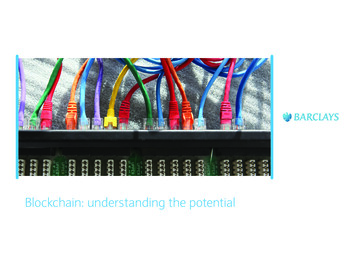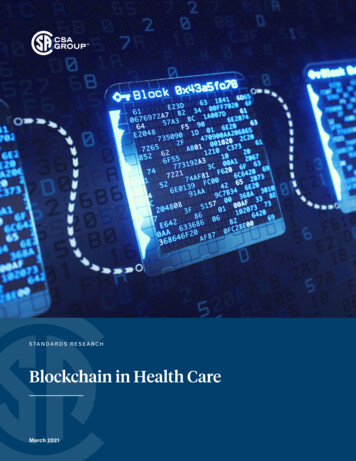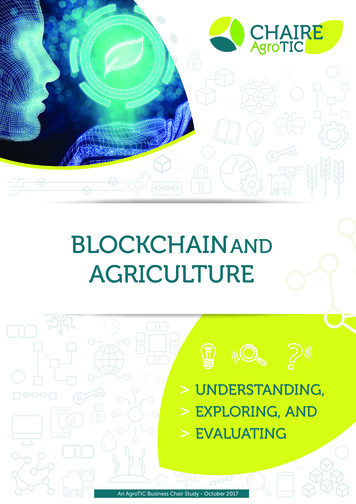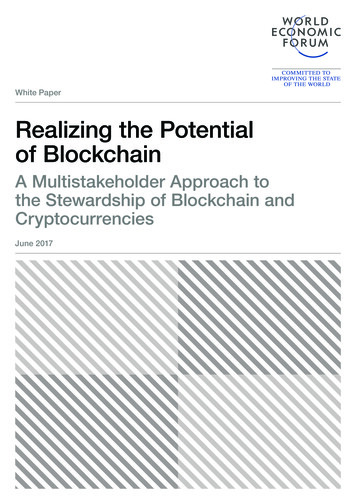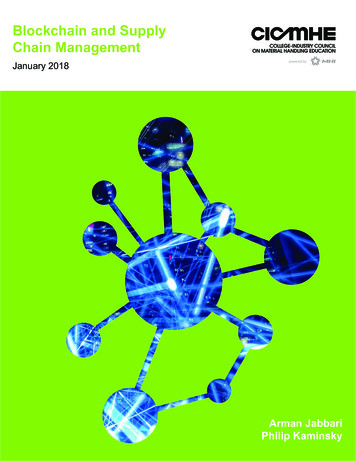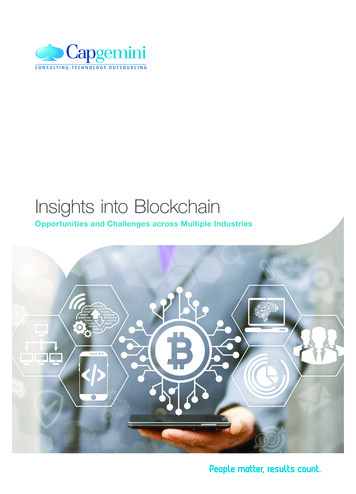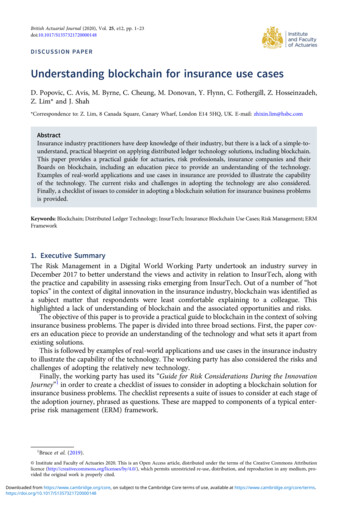
Transcription
British Actuarial Journal (2020), Vol. 25, e12, pp. 1–23doi:10.1017/S1357321720000148DISCUSSION PAPERUnderstanding blockchain for insurance use casesD. Popovic, C. Avis, M. Byrne, C. Cheung, M. Donovan, Y. Flynn, C. Fothergill, Z. Hosseinzadeh,Z. Lim* and J. Shah*Correspondence to: Z. Lim, 8 Canada Square, Canary Wharf, London E14 5HQ, UK. E-mail: zhixin.lim@hsbc.comAbstractInsurance industry practitioners have deep knowledge of their industry, but there is a lack of a simple-tounderstand, practical blueprint on applying distributed ledger technology solutions, including blockchain.This paper provides a practical guide for actuaries, risk professionals, insurance companies and theirBoards on blockchain, including an education piece to provide an understanding of the technology.Examples of real-world applications and use cases in insurance are provided to illustrate the capabilityof the technology. The current risks and challenges in adopting the technology are also considered.Finally, a checklist of issues to consider in adopting a blockchain solution for insurance business problemsis provided.Keywords: Blockchain; Distributed Ledger Technology; InsurTech; Insurance Blockchain Use Cases; Risk Management; ERMFramework1. Executive SummaryThe Risk Management in a Digital World Working Party undertook an industry survey inDecember 2017 to better understand the views and activity in relation to InsurTech, along withthe practice and capability in assessing risks emerging from InsurTech. Out of a number of “hottopics” in the context of digital innovation in the insurance industry, blockchain was identified asa subject matter that respondents were least comfortable explaining to a colleague. Thishighlighted a lack of understanding of blockchain and the associated opportunities and risks.The objective of this paper is to provide a practical guide to blockchain in the context of solvinginsurance business problems. The paper is divided into three broad sections. First, the paper covers an education piece to provide an understanding of the technology and what sets it apart fromexisting solutions.This is followed by examples of real-world applications and use cases in the insurance industryto illustrate the capability of the technology. The working party has also considered the risks andchallenges of adopting the relatively new technology.Finally, the working party has used its “Guide for Risk Considerations During the InnovationJourney”1 in order to create a checklist of issues to consider in adopting a blockchain solution forinsurance business problems. The checklist represents a suite of issues to consider at each stage ofthe adoption journey, phrased as questions. These are mapped to components of a typical enterprise risk management (ERM) framework.1Bruce et al. (2019). Institute and Faculty of Actuaries 2020. This is an Open Access article, distributed under the terms of the Creative Commons Attributionlicence (http://creativecommons.org/licenses/by/4.0/), which permits unrestricted re-use, distribution, and reproduction in any medium, provided the original work is properly cited.Downloaded from https://www.cambridge.org/core, on subject to the Cambridge Core terms of use, available at rg/10.1017/S1357321720000148
2D. Popovic et al.2. Introduction to BlockchainInterest in blockchain has risen and then waned as it failed to gain mass adoption. However, theintellectual capital, and collective energy invested in the development of blockchain, means that atipping point is inevitable. This is the so-called Amara’s law2 which states that “we tend to overestimate the effect of a technology in the short run and underestimate the effect in the long run”.As has the Internet done for the exchange of information, blockchain is an infrastructure technology that will enable a peer-to-peer instantaneous exchange of value. Once mature and adopteden masse, it has the potential to be disruptive to the insurance industry’s existing business andoperating models. For example, the pooling/aggregating and transferring of risk could be achievedbetween end users (individuals, communities, and corporations) without (re)insurance/brokercompanies acting as intermediaries.2.1 What Is Blockchain?There is no single definition of blockchain; any attempt at a definition often spirals into semanticdisputes. For the purpose of this paper, the working party uses the following definition to set abaseline and common understanding.Blockchain, a variant of Distributed Ledger Technology (DLT), is a shared database/ledger onwhich the state (i.e. the current snapshot of data) is confirmed and verified without the need fora trusted centralised authority.At its most basic level, blockchain is a database which is shared by multiple participants. Data areverified by multiple entities instead of a single organisation. The data are then propagated andstored by each participant.The focus of this paper is less on the technical definition of blockchain and more on how itcould be useful in solving insurance business problems. This paper uses the terms “blockchain”,“distributed ledger technology (DLT)”, “database” and “ledger” interchangeably as umbrellaterms. The working party also recognises that blockchain is a variant of DLT and that thereare technical differences in various DLT platforms.2.2 How Is Blockchain Different?The defining features of blockchain/DLT that set it apart from existing technologies are as follows. It provides a single source of truth – this enables the exchange of value digitally without theneed for a central authority, who often acts as an intermediary. An intermediary typicallyextracts value from transactions to the detriment of the end users. Smart contracts deployed on a blockchain can automate business logic – this has thepotential to reduce operational frictions and costs and hence improve business processefficiencies.2.2.1 Single source of truthBlockchain-based solutions could serve as the single source of truth as they have the followingcharacteristics.2Amara (2006).Downloaded from https://www.cambridge.org/core, on subject to the Cambridge Core terms of use, available at rg/10.1017/S1357321720000148
British Actuarial Journal3 Distributed – verified data are propagated to participants on the blockchain network so thatmultiple parties have the same record. This solves the problem of data existing in silos andremoves the need for reconciliation between multiple parties. Decentralised – in addition to data being propagated to and stored by multiple participants,the maintenance of the network, including data verification, does not depend on a centralisedauthority. This removes a central point of failure. Tamper-resistant – verified data are cryptographically secured, making the data resistant tomalicious alterations. This provides a high degree of data integrity and immutability. Transparent – the blockchain is fully auditable for those with access.Conventional, tried-and-true database solutions may have some of these characteristics; what setsblockchain apart is that it is designed from the ground-up with all of these characteristics in mind.2.2.2 Smart contractsSmart contract is an umbrella term for self-executing code deployed on the blockchain, analogousto software that runs on a computing platform. When pre-defined criteria are met, smart contractsexecute a set of business logic as agreed by participants involved. While they may not be “contracts” in a legal sense, they could be utilised to implement the automatic execution of a legalcontract or agreement.Self-executing code is not new; smart contracts are innovative in that they act on dependabledata within the blockchain (on-chain data). Where data are not available on the blockchain, offchain data from external sources known as “oracles” (e.g. market data provider for financial contracts and weather data provider for weather-related insured events) could be used to trigger thepre-defined action(s).Smart contracts are important as they extend the functionality of blockchain as a shared database to that of a platform for building a wide array of applications (see examples of insurance usecases in section 3).2.3 How Does It Work? A Non-Technical OverviewBlockchain is a convergence of multiple disciplines, including programming, information security,cryptography, distributed systems, and peer-to-peer networks. To fully grasp its inner workings,one needs a fundamental understanding of these subject matters, which is beyond the scope ofthis paper.Instead, the paper provides a high-level overview by focusing on: the trade-offs in blockchain design choices – this section provides an overview of the designconsiderations when choosing the most suitable blockchain solution for a given use case; the key components of blockchain/DLT technology – this section introduces the componentsof blockchain. A basic knowledge of these is useful in developing blockchain applications.However, like web application developments, an extensive knowledge of the underlying protocols is not required.Readers are referred to Nakamoto (2008), Buterin (2013), Hearn & Brown (2019) and Amsdenet al. (2019) for further reading.Downloaded from https://www.cambridge.org/core, on subject to the Cambridge Core terms of use, available at rg/10.1017/S1357321720000148
4D. Popovic et al.2.3.1 Trade-offs in design choicesThere are two broad classifications of blockchains as shown in Table 1.Table 1. Broad Classifications of BlockchainsAccessExamples ofplatformPermissionlessblockchainAnyone can participate in, maintainand secure the network.EthereumPermissionedblockchainOnly authorised entities can participate in thenetwork with various degrees of read–write–validate access.Corda,HyperledgerFabric, LibraThe differences are born out of design choices and trade-offs that favour certain features overanother. This, in turn, may give one platform an edge over another in specific use cases.The key trade-off between permissionless and permissioned blockchain is that of access versusprivacy. Permissionless blockchains provide frictionless access, that is, anyone can participate inthe network as opposed to the need to set up governance around the rules of participation in apermissioned blockchain. More importantly, anyone can develop applications (via smart contracts) on permissionless blockchains, potentially increasing the pace of innovation. However,transactions or changes to the database are transparent to all participants; this may not be acceptable in business use cases which require confidentiality.Figure 1. Examples of design trade-offs.Other important (but non-exhaustive) design trade-offs, as shown in Figure 1, include: Decentralisation versus scalability/speed – To maximise the benefits of decentralisation(i.e. where the ownership and maintenance of the network, including data verification, doesnot depend on a trusted centralised authority), scalability/speed of the network needs to besacrificed in favour of a robust decentralised consensus mechanism; Scalability/speed versus security – To maximise throughput (i.e. the number and speed oftransactions), certain design sacrifices need to be made to the rules that determine how dataare verified and added to the shared database, potentially introducing vulnerabilities;Downloaded from https://www.cambridge.org/core, on subject to the Cambridge Core terms of use, available at rg/10.1017/S1357321720000148
British Actuarial Journal5 Development flexibility versus security – To maximise the flexibility in developing applications, restrictions on smart contracts may need to be minimised, potentially allowing malicious actors to exploit software bugs in smart contracts.2.3.2 Components of blockchainComponents of blockchain are not new; the main innovation is in the mixing and aggregation ofexisting technologies such as cryptographic hash functions, digital signature, Merkle tree (or itsvariants) data structure and consensus mechanism in a distributed system. These components aredescribed further below.2.3.2.1 Cryptographic hash function. Cryptographic hash functions are used extensively throughouta blockchain system to secure and authenticate data. A cryptographic hash function is a “mathematical algorithm that maps data of arbitrary size (often called the ‘message’) to a bit string of afixed size (i.e. the ‘hash’ or ‘digest’) and is a one-way function, that is, a function which is practically infeasible to invert”.3A small change to the input, as shown in Figure 2, would change the hash/digest that the newhash appears uncorrelated with the old hash. The only way to find the input that produces a givenhash is to attempt a brute-force search of possible inputs to see if they produce a match.Figure 2. A cryptographic hash function (i.e. SHA-1) at work (Wikipedia, n.d.-a).2.3.2.2 Digital signature. Digital signature, which serves as a unique fingerprint, provides theassurance that the proposal to change the state (i.e. the current snapshot of the data) of theblockchain originates from a network node that is authorised to do so. This is achieved usingasymmetric cryptography, where a pair of “keys” – one public, and the other private – couldbe used to encrypt and decrypt data as shown in Figure 3.3Wikipedia, n.d.-a.Downloaded from https://www.cambridge.org/core, on subject to the Cambridge Core terms of use, available at rg/10.1017/S1357321720000148
6D. Popovic et al.Figure 3. Example of digital signature in the context of signing a message from Alice to Bob, and used to verify the message(Wikipedia, n.d.-b).An overview of how this works is as follows. The proposal is “signed” with the node’s private key using a digital signature algorithm. Theprivate key is known only to the node. The signed proposal can be verified to have originated from the node by using the node’spublic key and digital signature algorithm. A digital signature is unique to each state change request, thereby adding extra security (i.e.the same signature cannot be re-used).2.3.2.3 Merkle tree-type data structure. Merkle trees allow for efficient verification of data integrity.A Merkle tree is a tree of hashes constructed from the bottom up as shown in Figure 4. Each leafnode4 is a hash of data (e.g. transactions), and each non-leaf node is a hash of its child nodes,culminating in the top node (i.e. the root hash or the Merkle root).Such a data structure optimises the storage and verification of data in a blockchain. Data storage is optimised because only the hashes need to be saved and the root hash is the fingerprint ofthe entire data set. Data verification is optimised because only a small part of the tree needs to betraversed in order to check where changes have occurred.Figure 4. Transactions hashed in a Merkle Tree (Nakamoto, 2008).“Nodes”, when used in the context of a Merkle tree, refer to hashes. This is not to be confused with a “node” in the blockchain network, that is, a participant in the network.4Downloaded from https://www.cambridge.org/core, on subject to the Cambridge Core terms of use, available at rg/10.1017/S1357321720000148
British Actuarial Journal7The root hash/Merkle root, the fingerprint of the entire data set, forms part of the block headeron the blockchain. Another component of the same block header is the hash of the previous block.This unique data structure, where blocks are chained together as shown in Figure 5, is a distinctivefeature of blockchain that makes it tamper-resistant. This is because a data change would cause theblock hash to change, making it incompatible with the block header in the next block. Therefore, anadversary who wishes to change the state of a particular block would need to change all subsequentblocks. In a proof-of-work (PoW) consensus mechanism (see section 2.3.2.4), this would requiremore than half the computing power of the whole blockchain network (known as the 51% attack).Figure 5. Previous states are linked to the current state (Nakamoto, 2008).2.3.2.4 Consensus mechanism. The consensus mechanism is a set of rules that determines how dataare verified, how conflicting information is resolved, and how agreement is reached on committing changes to the blockchain without a trusted centralised authority.By utilising cryptography and behavioural economics, the mechanism ensures that participantsare strongly incentivised to maintain and secure the network. Examples of consensus mechanismare summarised in Table 2.Table 2. Examples of Consensus MechanismConsensusmechanismHigh-level methodTypicalblockchaintypeIncentivePermissionless “Miners” who providecomputational powerare rewarded and paidtransaction fees (in theform of the digitalcurrency/token nativeto the blockchain) onsuccessfulcommitment of statechanges to theblockchainProof-of-Work(PoW)Requires solvingcryptographic puzzleby brutecomputational forcefor a state change tobe committed to theblockchainProof-of-Stake(PoS)Permissionless The validator who isUnlike PoW whereselected is rewardedminers compete toon successfulcommit state changescommitment of stateto the blockchain, PoSchanges to theselects from a pool ofblockchain but riskvalidators who hold alosing a portion ofcertain amount of thetheir stake otherwisedigital currency/tokennative to theblockchain(i.e. the stake)PermissionedProof-of-Authority Trusted entities vote(PoA)on whether to committhe state changes tothe blockchainThe governance set upfor the permissionedblockchain wouldagree on the penaltyto be imposed on nonperforming entitiesKey pros and cons Pros: Has the longesthistory in productionuse (i.e. it has beenused in real-worldadversarial conditions);vulnerabilities arerelatively well knownand could be mitigatedagainst Cons: significantelectricity usage/wastage Pros: Significantly lesselectricity usage Cons: It is at a proof-ofconcept (PoC) stageand has not beenrigorously tested inreal-world conditions Pros: High throughputand low latency (i.e.high number andspeed of transactions) Cons: Effective only in aclosed, permissionedblockchain.Downloaded from https://www.cambridge.org/core, on subject to the Cambridge Core terms of use, available at rg/10.1017/S1357321720000148
8D. Popovic et al.3. Insurance Use CasesCompelling use cases in the insurance industry arise when there is a need to remove intermediaries in the process of value transfer/exchange; produce a shared tamper-resistant record that is trusted by multiple participants and allstakeholders; reduce operational frictions and costs in the value chain.Figure 6 summarises examples of real-world5 use cases. The potential application of blockchaintechnology is evident throughout the insurance value chain, that is, from the underwriting andpricing of products, their sales and distribution, through to the ongoing management of product,and claims processing. The examples below are not exhaustive, and in some cases, the use ofblockchain technology may not be strictly required. However, blockchain could be an enablerand catalyst to accelerate digitisation, shift the mindset towards change and transformationand foster further innovation.The following sections discuss the use cases in more detail, covering the problem statement, ahigh-level description of the use case, main beneficiaries of the use case, the benefits (other thancost savings) and challenges preventing adoption. Many of these use cases are work-in-progressand are ordered roughly by time to adoption (imminent to long term).Figure 6. Examples of use cases across the insurance value chain.5As it is not possible to identify an exhaustive list of companies and projects working on these use cases, companies/projectsare not named in this paper to avoid implicit endorsement. Additionally, the success rate of these projects is low historically;any named project may not exist or be relevant after the paper is published.Downloaded from https://www.cambridge.org/core, on subject to the Cambridge Core terms of use, available at rg/10.1017/S1357321720000148
British Actuarial Journal93.1 Claim ProcessingProblem statement The insurance claim process is a series of manual steps, for example,1. the policyholder fills in a form or makes a phone call to report the claim;2. the insurer asks for and verifies proof of insured event and insurer might also needto send out an adjuster to quantify the damage;3. the insurer receives all the details and pays out the claim, and if there is a dispute,the process will take even longer. The required data for processing a claim might be stored in silos which do notcommunicate with each other. Fraud is a potential issue as the policyholder could take advantage of weaknesses inthe claim process (information asymmetry and data silos). For the insurer, it might be a costly process because of manual administration,reconciliations, and settling disputes. For the policyholder, claiming in times of need or distress is an inconvenience.Blockchain solutiondescription The terms of the insurance product are written into a smart contract whichautomatically pays out claims upon receiving the right parameters. This is feasiblefor simple “parametric” insurance products where the claim trigger event is easilyverifiable from trustworthy publicly available data, for example, flight delay,extreme weather, natural catastrophes or death of a person (via ubiquitousbiometric sensors); Claims are recorded on the blockchain for auditability to prevent multiple claims onthe same insured event.Main beneficiariesIncumbents, start-ups, customersBenefits Improves customers’ experience. Prevents insurance fraud by eliminating double-claiming on the same event.Main challenge to massadoption No proven standards or platform. The lack of trustworthy third-party (i.e. oracles) data to trigger a claim on morecomplex insured events. Automatic processing/settlement is not new; blockchain and smart contract may notprovide a clear benefit over existing technology.3.2 Reinsurance and SwapsProblem statement A typical life reinsurance account takes 2 to 3 months to settle, that is, from thepoint the insurer pays out a claim to when it receives recovery from the reinsurer.This is mainly due to the time required to gather claims data, calculate reinsuredclaims/premiums, reconcile claims/premiums, settle disputes, etc. There are multiple parties trying to work on the same data but data are stored insilos. This slows down the reinsurance process and is prone to errors. When trying to make a deal (e.g. bulk annuity), considerable time is spent oncleansing data which could mean missing an opportunity to close a deal if the dataare not ready. Transactions involving collateral require third party to manage the collateral assets.This involves costs, and these assets may be double-pledged. For bulk annuities, it is difficult to track deferred lives because of a lack of shareddata. For longevity risk transfer, it is generally difficult to novate swaps because newtransacting party does not usually have full view of past claims history.(Continued)Downloaded from https://www.cambridge.org/core, on subject to the Cambridge Core terms of use, available at rg/10.1017/S1357321720000148
10D. Popovic et al.(Continued )Blockchain solutiondescription Reinsurance treaties/swaps terms are written into a smart contract whichautomatically executes payments (premiums and claims) to/from reinsurers whenpre-determined conditions are met. Experience data are recorded on the blockchain which is tamper-resistant andimmediately auditable. All parties (i.e. insurers, reinsurers, third-party data providers, asset managers andconsultants) record data on the blockchain so everyone has access to a single versionof the truth. For bulk annuity deals, cleansed data could be stored on the blockchain which istamper-resistant and all participants could see what changes have been done. All transactions (reinsurance premiums and claims) are recorded on the blockchainfor visibility to future transacting parties.Main beneficiariesIncumbents, start-upsBenefits Reduces complexity of contracts (simplification is by necessity as contract rulesare coded rather than in legal prose). More liquid and transparent market for reinsurance deals. Facilitates a secondary market of insurance-linked securities (ILS). In the longer term, once a standard/platform has emerged, standardised datacollection and verification will lead to more reliable data; reduced lead time from data submission to price quotes; simplified regulatory reporting requirements.Main challenge to massadoption No proven standards or platform. However, industry consortia, such as B3i(Blockchain Insurance Industry Initiative), are working to establish an enterpriseblockchain standard.3.3 Tokenisation of Insurance Risk (i.e. Securitisation on the Blockchain)Problem statement Intermediaries extract fees from securitising insurance risk, reducing the capitalraised. Insurers incur costly expenses in the administration of the securitised book ofbusiness. Investors often do not have a transparent view of the underlying insurance risk.Blockchain solutiondescription Blocks of insurance business are escrowed on the blockchain, and smart contractsare used to trigger payments to investors when pre-determined conditions aremet. This is similar to the reinsurance use case but applied to the capital market. The ILS is packaged into a “token”, that is, a digital representation of the ILS,potentially widening the investor base (subject to regulatory constraints).Main beneficiariesIncumbents, start-ups, investorsBenefits A cost-effective way of raising capital and to transfer risk, that is, no fees tointermediaries (e.g. investment banks). Increases information flow to investors, that is, cashflows arising from the block ofbusiness are recorded on the blockchain and are auditable. Improves liquidity of the ILS market via informed price discovery as a result of theincreased information flow to investors.Main challenge to massadoption No proven standards or platform; Security laws and regulations around digital representation of assets are not clear.Downloaded from https://www.cambridge.org/core, on subject to the Cambridge Core terms of use, available at rg/10.1017/S1357321720000148
British Actuarial Journal113.4 Decentralised Digital IdentityProblem statement Compliance to data protection and Know-Your-Customer (KYC) regulations arecostly and onerous. Customers have no control over their personal data and to whom it is shared with.Blockchain solutiondescription Customers’ private information is owned and stored locally by customers;blockchain acts as a trusted conduit of data from customers to insurers. Regulatory KYC requirements are codified into a smart contract and automated.Main beneficiariesIncumbents, start-ups, customersBenefits Insurers could choose not to store customers’ private data. Hence, limits the attack surface, that is, reduces data breach risk; reduces the onus of complying with data privacy rules. Customers retain full ownership of their data and control with whom they share whatdata. Customers could share the same data with multiple insurers, enabling frictionlessquote generation. Any changes to personal data could be passed on to insurers in real time. Advanced encryption techniques such as zero-knowledge proofs (ZKPs) mean thatcustomers could share minimal personal data for KYC checks.Main challenge to massadoption The enabling technology is only just emerging; digital identity is a public good;private enterprises are least incentivised to develop the infrastructure necessaryfor the technology to work. Insurers need to change the way they consume data as data are not stored by theinsurer; Customers would need to change their mindset with regards to how they manage andpossibly monetise their personal data. They need to have the confidence andincentive to share their personal data in return for more benefits, e.g. cheaperpremium, personalised products, and faster underwriting.3.5 Decentralised Data LakeProblem statementThe proliferation of sensors and connected devices has led to a rise in digital data.These are often in siloed data lakes managed disparately by numerous entities(with various degree of data security processes).Blockchain solutiondescriptionData from sensors and connected devices are recorded directly on a blockchainbased platform. A data marketplace can be created to incentivise the collection andsharing of data.Main beneficiariesStart-ups, customersBenefits Tamper-resistant, verifiable data source; Democratise access to advantageous pricing data. For example, incumbent insurershave access to customers’ wearable data collected over the years. The creation of adecentralised data market place where such information can be sold directly bycustomers and purchased by start-ups will level the playing field.Main challenge to massadoptionThe technology is available but such a market place is ahead of its time; adoptionwill require a cultural shift.Downloaded from https://www.cambridge.org/core, on subject to the Cambridge Core terms of use, available at rg/10.1017/S1357321720000148
12D. Popovic et al.3.6 Decentralised Autonomous InsurerProblem statementThe existing insurance business and operating model is not optimised for thebenefits of policyholders due to the need to return capital to sharehold
There is no single definition of blockchain; any attempt at a definition often spirals into semantic disputes. For the purpose of this paper, the working party uses the following definition to set a baseline and common understanding. Blockchain, a variant of Distribute
